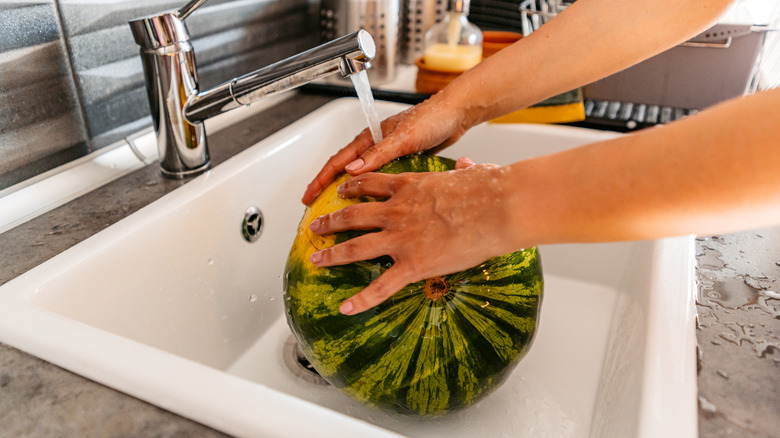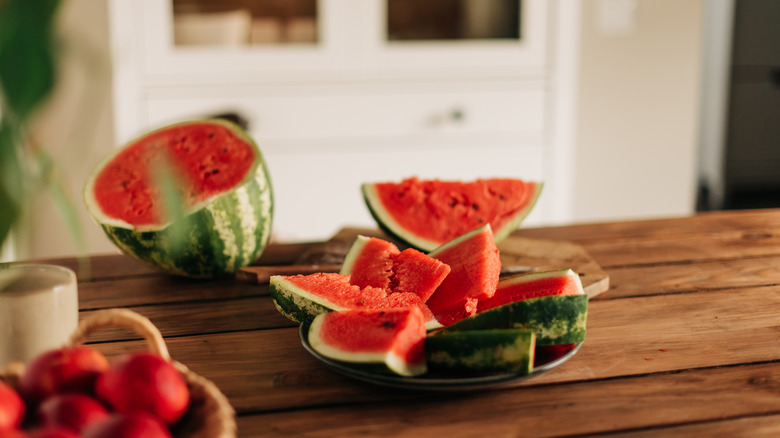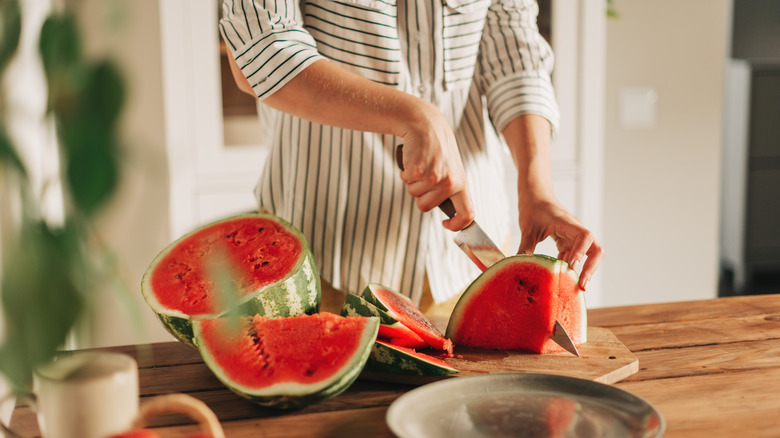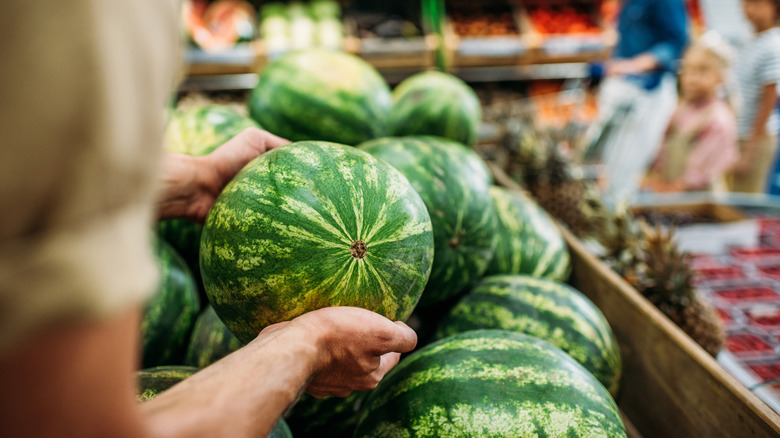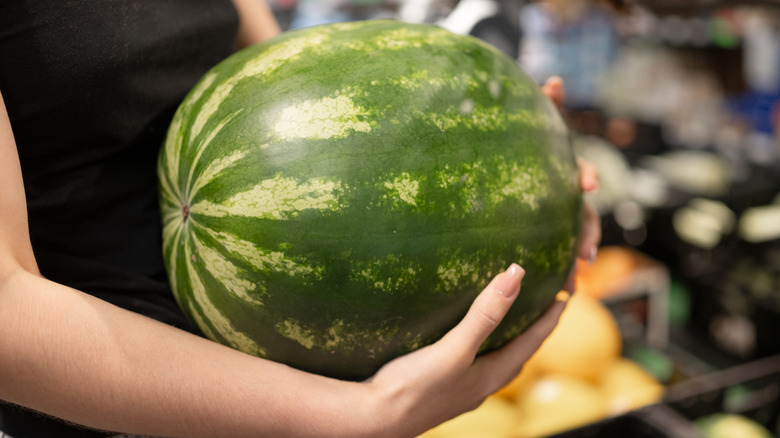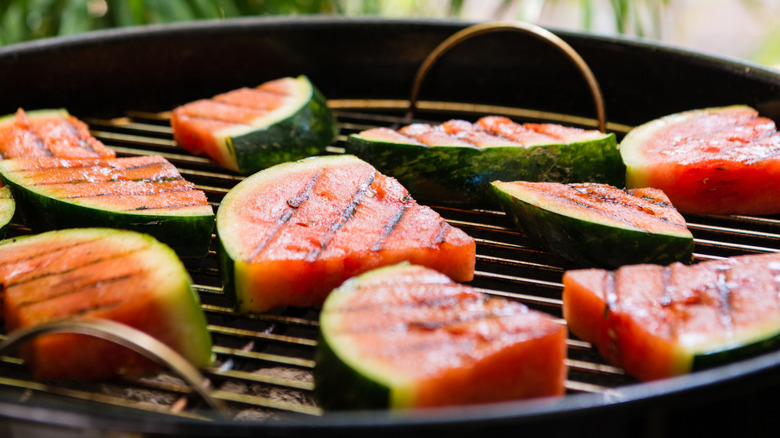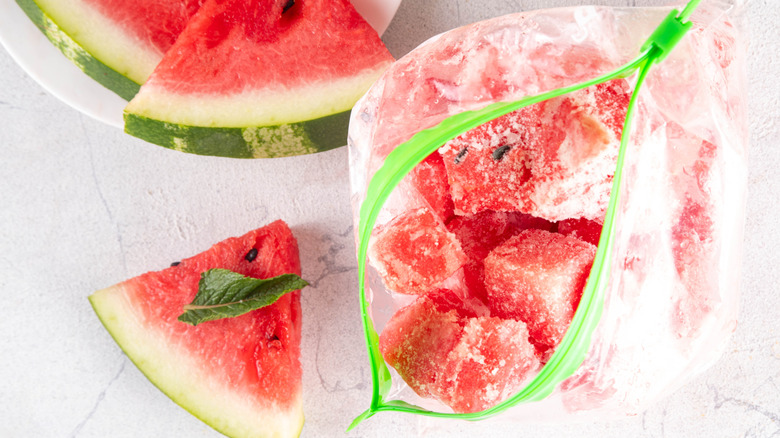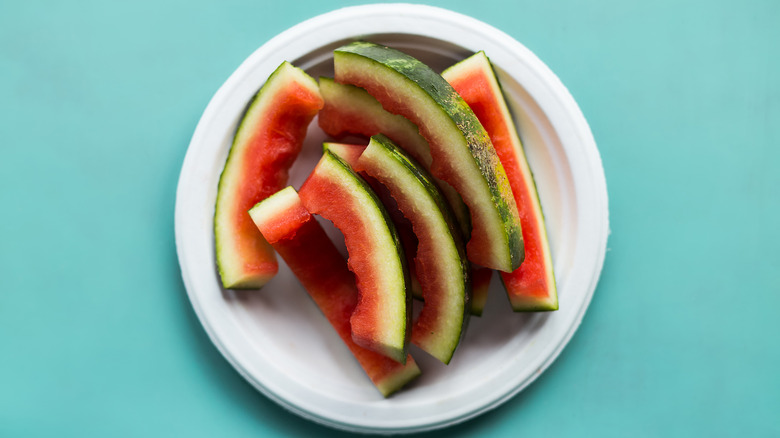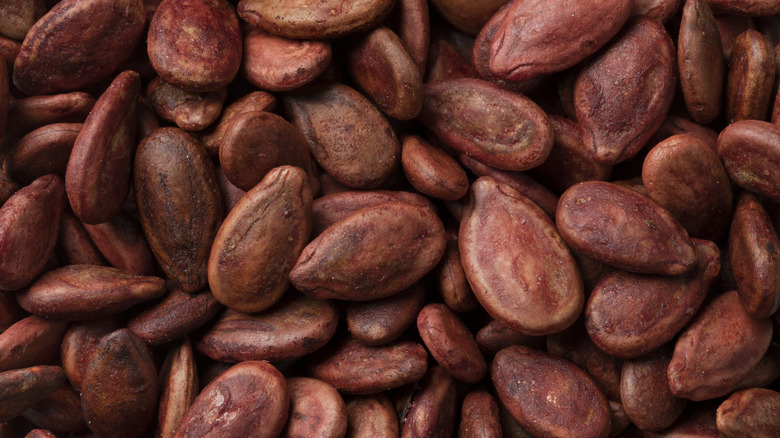10 Mistakes Everyone Makes With Watermelon
Nothing says summer like a big slice of juicy, sweet watermelon. The fruit — which likely originated in northeastern Africa, but is now cultivated in countries all over the world — is a hot-weather classic. It's hydrating, delicious, and packed with goodness, providing plenty of reasons why you should start eating more watermelon.
In fact, watermelon is a source of vitamins A and C, fiber, and antioxidants like lycopene. The latter nutrient is associated with a reduced risk of chronic diseases, including cancer and heart disease. But one of the biggest reasons why so many of us love watermelon is the taste, of course. It's not just pleasantly sweet, but it's also tangy and a little bitter, too. All of these flavors work in harmony to produce a super-tasty snack.
If you feel like you're not getting the best out of your watermelon, there are probably a few simple reasons for that. It might be that it has a low water content, for example, or it's either underripe or overripe, which can impact the taste. There are also a few important hygiene rules to keep in mind with watermelon, like always washing it before you eat it, and never cutting it and then leaving it out for a long time at room temperature. To help you enjoy the tastiest, healthiest watermelon and figure out what not to do, we've gathered some of the most common mistakes people make with watermelon.
Not giving watermelon a wash before you eat it
As mentioned earlier, watermelons are packed with nutrients, which makes them a healthy addition to most people's diets. However, sometimes they can be contaminated with bacteria, which turns them into a health hazard. In 2012, for example, it was determined that a salmonella outbreak in the U.K. impacted at least 35 people, and caused one person's death. All melons, including watermelon, can come into contact with unwanted germs either during harvesting, in the grocery store, or at home.
To keep yourself safe from foodborne bacteria, the best thing to do is to wash your watermelon right before you consume it. This is because when slicing the fruit, any bacteria left on the exterior can be pushed into the flesh of the melon. Due to the sheer size of the fruit, you'll need a big space to wash it. The kitchen sink should do the trick — just make sure to sanitize it first, as sinks can also harbor bacteria.
When considering how to clean your watermelon, what you need to know about washing any fruits and veggies is that if you really want to be certain that external bacteria is gone, you can also spray or rinse them with vinegar. This is because vinegar contains acetic acid, which is effective at killing unwanted germs (including salmonella, and other nasty pathogens like E. coli and listeria).
Leaving cut watermelon out for too long at room temperature
It might be tempting to slice your watermelon and leave it on the counter for easy snacking throughout the day — but if you know that the melon won't be eaten quickly, it's safer to store it in the fridge. This is because if it's left for more than two hours at room temperature, cut watermelons (like many foods) are at a greater risk of growing bacteria. Cut watermelon should always be kept out of the food-temperature danger zone, which is between 40 and 140 degrees Fahrenheit.
There are a few ways to store cut watermelon safely without sacrificing its juicy texture and natural sweetness. After being cut, watermelon slices can be preserved for five days or possibly longer if stored in the fridge within an airtight container or sealed plastic bag.
However, if the watermelon is left intact and the inner flesh is not exposed to air, you can leave the fruit on the counter safely, usually for up to one week. On a watermelon, the tough outer rind serves as a protective shield for the flesh inside. This is the same for most fruits with a skin, like apples, oranges, and pineapple.
Not using a large, very sharp knife to cut watermelon
A watermelon's tough rind might be perfect for keeping its contents safe from harmful bacteria, but it does make cutting the fruit difficult — especially given the size of most watermelons. However, don't be intimidated. There is a technique for how to cut a watermelon that will make the process easier.
The first step is to reach for a large, very sharp knife. This will help you glide through that tough exterior, but it will also reduce the risk of hurting yourself. A sharp knife makes for a clean and efficient slice, while a dull knife requires more pressure and is more prone to slippage — which could mean accidentally cutting your fingers, and nobody wants to head to the emergency room instead of eating their delicious watermelon.
Start by cutting the watermelon in half lengthwise, slowly and carefully, before cutting each half in half again. If you want to enjoy the fruit in slices, simply cut the watermelon quarters through the rind into triangular wedges. If you prefer cubes, you can continue cutting by slicing the knife into the red part of the flesh to create smaller slices, but stopping when you get to the hard rind. Then run the knife along the rind and remove the pieces of watermelon. From there, you can continue slicing the pieces until you have your desired shape and size.
Not paying attention to a watermelon's color, appearance, and sound before buying
The secret to the most delicious watermelon is choosing the right one. Many methods can be utilized when considering how to tell if a watermelon is good, but first, a warning: When carrying out these tips, you might look a little silly at the grocery store. However, trust us — it's worth looking silly for a juicy, tasty fruit snack.
The first thing to do is to look at the color. If a watermelon has light yellow and dark green stripes on the rind, this indicates that the inside is ripe and juicy. It can be tempting to opt for the shiniest melon of the batch, but a shiny rind actually indicates that the melon isn't quite yet ready to eat. You should also look for the melon's field spot, which is a larger yellow patch. If it's creamy in color or orangey, the melon is probably a winner. If the field spot is white, that watermelon is probably not the best. It's also a good idea to avoid any watermelons with obvious bruises or blemishes.
The next important thing is to listen to your watermelon. Yep, we told you this was going to get silly. But the truth is, the sound of a watermelon when someone knocks on it can tell a lot about its flavor. If you knock on a watermelon with your knuckle and the sound is deep and hollow, it's probably ripe and ready. If the melon produces a muted sound, it's probably not ripe yet.
Opting for the lightest watermelon in the store
Appearance, color, and sound are vital when it comes to selecting the best watermelon on offer, but weight is also important. It might be tempting to go for the lightest one you can find (especially if you're carrying it home) — but actually, a denser, heavier watermelon is likely going to have the best taste. This is because heaviness implies a higher water content, which means the watermelon will taste juicier and sweeter.
Fun fact: On average, a watermelon is 92% water. This means it's not just juicy and refreshing, but also pretty hydrating, too. In fact, just 1 cup of sliced watermelon contains more than half a cup of water. This makes it a great fruit to enjoy in the summer, when it's more important to stay hydrated, as we lose more water through sweat in high temperatures. So, the heavier the watermelon you choose, the more hydrated you're going to be, and the more enjoyable it's going to be to eat.
Never seasoning watermelon
If you pick a good watermelon with a sweet, juicy, perfectly ripe interior, it is already going to taste delicious. But there are ways you can take the flavor to the next level, and one of them is to learn some of the delicious ways to season watermelon. The best seasoning for your watermelon depends on your individual taste. If you like a little subtle spice, for example, consider opting for Tajín seasoning, which is a Mexican blend of dried granulated chilies, dehydrated lime, and sea salt. If you like your fruit to be really, really sweet, consider drizzling your watermelon with a little agave syrup, maple syrup, honey, or even sugar.
Mint is also a popular seasoning choice for watermelon, thanks to its light, refreshing taste. This is a popular way of eating the fruit in Egypt, for example, where it's often enjoyed in a light salad with feta cheese, mint, red onions, and black olives. And for those who like a little zing, you can't go wrong with a drizzle of lemon or lime juice on your watermelon slice. For spice lovers, jalapeños and cayenne peppers also go surprisingly well with the ultra-sweet flesh of watermelon.
In Southern states, like Florida and Alabama, it's common practice to sprinkle a little salt on watermelon. This helps to balance out the bitterness, and bring out more of the fruit's natural sweet flavor. It can also help attract more liquid to the surface of the fruit, too.
Only eating watermelon raw
In 2018, Duck's Eatery, a restaurant in New York City, went viral for serving up smoked watermelon that looked just like meat. The restaurant, which is no longer in operation, sold the watermelon "ham" for $75. The lofty price was due to the extensive amount of time required to prepare the delicacy — the watermelon had to be cured for up to six days before being dried and then smoked for eight hours. The flavor was worth it, however, and demand was high for the unique menu item.
Don't worry — if you want to experiment with cooked watermelon, you don't have to set aside several days for preparation. Simply popping a few watermelon slices on the grill at your next summer cookout will bring out a caramelized, smoky flavor, and it takes just a few minutes. You can also turn watermelon into a vegan substitute for tuna steak by cooking it. Simply season it first with a mix of ingredients like rice vinegar, sesame oil, and soy sauce, and dry it out by baking it for an hour. You'll be left with a slab of watermelon that looks and tastes surprisingly like tuna.
Another option is to try making a refreshing watermelon curd recipe. You can do this by extracting the watermelon's juice and mixing it with eggs, sugar, butter, and cornstarch. After that, heat it all in a pan with lemon juice and stir constantly before chilling it. After that, you've got yourself a sweet, sticky, versatile curd.
Never freezing watermelon
Another important factor to consider when you're buying watermelon is the season. This fruit is best enjoyed when it is naturally harvested, which tends to be between May and September. This means your watermelon will be ripe, juicy, and deliciously sweet.
However, there is a way to make your watermelon last longer. If you buy the fruit at the end of the season, ripe watermelon can be frozen for later, and then it'll be ready to enjoy throughout the fall. However, there is one downside to freezing watermelon. Because of its high water content, it does tend to get a little mushy when it's thawed out after being frozen. That said, frozen watermelon will still be perfect for blending into a smoothie or juice, for example, alongside other fruits like berries and bananas. Alternatively, you could use it to make homemade watermelon lemonade, a creamy DIY watermelon pineapple swirl Dole Whip, or even watermelon sorbet.
Freezing watermelon is a simple process. Cut it into pieces first (using a sharp knife, of course), and remove the seeds and the rinds. Spread the pieces out evenly on a baking tray, and place the tray in the freezer for a few hours — this will help stop the watermelon pieces from sticking together. Once frozen, just move the pieces to an airtight plastic bag or container, and place them back in the freezer.
Throwing away the rinds
When you've sliced up your watermelon, you probably throw the rinds in the trash or the compost heap. But actually, the tough exterior of this fruit is edible — and the reason why you should be saving your watermelon rind is that it's incredibly nutritious. In fact, the rinds contains citrulline, an amino acid that some research has associated with lowering blood pressure, and even improving libido and athletic performance. On top of this, the rind of the watermelon is a good source of fiber, which helps to support gut, digestive, and bowel health. It also contains important vitamins and minerals, like vitamins A and C, potassium, and magnesium.
Of course, the prospect of snacking on raw watermelon rind is not too appealing. It's tough, chewy, and generally unpleasant. But there are other ways that you can include rind in your diet. When it's puréed, for example, watermelon rind is incredibly versatile, and can be added to juices, smoothies, or even cold soups. If you like tangy foods, you can even pickle watermelon rind.
Using up the rind also comes with another benefit: reducing food waste. Right now, research suggests that well over 100 billion pounds of food is wasted in the U.S. every year. Beyond the loss of resources that go into producing this food, this situation is a problem because food waste is a major source of greenhouse gas emissions. Simple changes in your habits — like not discarding watermelon rind — can help to reduce your individual food-waste footprint.
Not cooking the seeds
Another part of the watermelon that usually gets wasted is the seeds. In fact, many people hate watermelon seeds so much, they opt for the seedless variety. Scientists first discovered that they could cultivate watermelons without seeds more than 50 years ago, and since then, the market for this variety has exploded. These days, more than 90% of watermelons sold in the U.S. are seedless.
Are watermelon seeds safe to eat? Actually, just like the rind, watermelon seeds (which can be white or black) are not just edible, but they are nutritious, too. In fact, watermelon seeds are a good source of magnesium, iron, zinc, and healthy unsaturated fats, including monounsaturated fats and polyunsaturated fats.
That said, you probably don't want to eat seeds straight from the watermelon — they're unlikely to do you any harm, but they're just not as enjoyable. Instead, you can roast them similarly to sunflower seeds, with salt and a little bit of olive oil for a tasty nutritious snack. They're also a good topping choice for dishes like salads, soups, and yogurt.

